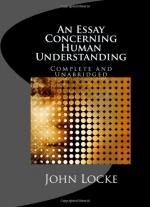that figure, and had such a particular frame of its
visible parts. Such an opinion as this, placing
immortality in a certain superficial figure, turns
out of doors all consideration of soul or spirit;
upon whose account alone some corporeal beings have
hitherto been concluded immortal, and others not.
This is to attribute more to the outside than inside
of things; and to place the excellency of a man more
in the external shape of his body, than internal perfections
of his soul: which is but little better than
to annex the great and inestimable advantage of immortality
and life everlasting, which he has above other material
beings, to annex it, I say, to the cut of his beard,
or the fashion of his coat. For this or that
outward mark of our bodies no more carries with it
the hope of an eternal duration, than the fashion of
a man’s suit gives him reasonable grounds to
imagine it will never wear out, or that it will make
him immortal. It will perhaps be said, that nobody
thinks that the shape makes anything immortal, but
it is the shape that is the sign of a rational soul
within, which is immortal. I wonder who made
it the sign of any such thing: for barely saying
it, will not make it so. It would require some
proofs to persuade one of it. No figure that
I know speaks any such language. For it may as
rationally be concluded, that the dead body of a man,
wherein there is to be found no more appearance or
action of life than there is in a statue, has yet
nevertheless a living soul in it, because of its shape;
as that there is a rational soul in a changeling,
because he has the outside of a rational creature,
when his actions carry far less marks of reason with
them, in the whole course of his life than what are
to be found in many a beast.
16. Monsters
But it is the issue of rational parents, and must
therefore be concluded to have a rational soul.
I know not by what logic you must so conclude.
I am sure this is a conclusion that men nowhere allow
of. For if they did, they would not make bold,
as everywhere they do to destroy ill-formed and mis-shaped
productions. Ay, but these are monsters.
Let them be so: what will your drivelling, unintelligent,
intractable changeling be? Shall a defect in
the body make a monster; a defect in the mind (the
far more noble, and, in the common phrase, the far
more essential part) not? Shall the want of a
nose, or a neck, make a monster, and put such issue
out of the rank of men; the want of reason and understanding,
not? This is to bring all back again to what was
exploded just now: this is to place all in the
shape, and to take the measure of a man only by his
outside. To show that according to the ordinary
way of reasoning in this matter, people do lay the
whole stress on the figure, and resolve the whole
essence of the species of man (as they make it) into
the outward shape, how unreasonable soever it be, and
how much soever they disown it, we need but trace their




